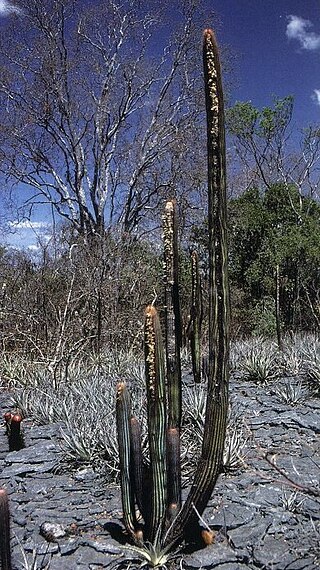
São Domingos is a municipality in northeastern Goiás state, Brazil. It is a large producer of beef cattle but is one of the poorest towns in the state.

Facheiroa cephaliomelana is a species of plant in the family Cactaceae.

Melocactus azureus is a species of cactus. It is endemic to Brazil, where it is known only from Bahia. It is locally abundant but the populations are fragmented and vulnerable to habitat degradation.

Micranthocereus albicephalus is a species of plant in the family Cactaceae. It is endemic to Brazil. Its natural habitats are subtropical or tropical dry shrubland and rocky areas. It is threatened by habitat loss.

Micranthocereus dolichospermaticus is a species of plant in the family Cactaceae. It is endemic to Brazil, where it is confined to the states of Bahia and Minas Gerais. Its natural habitat is rocky areas. It is threatened by habitat loss.

Micranthocereus streckeri is a species of plant in the family Cactaceae. It is endemic to Brazil. Its natural habitats are subtropical or tropical moist shrubland and rocky areas. It is threatened by habitat loss.

Micranthocereus violaciflorus is a species of plant in the family Cactaceae. It is endemic to Brazil.

Uebelmannia gummifera is a species of plant in the family Cactaceae. It is endemic to Brazil. Its natural habitat is dry savanna. It is threatened by habitat loss.

Uebelmannia pectinifera is a species of plant in the family Cactaceae. It is endemic to Brazil. Its natural habitats are dry savanna and rocky areas. It is threatened by habitat loss.

The Terra Ronca State Park was created by decree nr. 10,879 of 7 July 1989 and had its area and boundaries established by decree nr. 4,700 of 21 August 1996, covering the municipality of São Domingos. Around the state park they created the environmental protection area (APA) of the Serra Geral, by decree nr. 4,666 of 16 April 1996. The areas of these two protected areas are of restricted use and regularly monitored and audited by the Agência Goiana de Meio Ambiente e Recursos Naturais, covering respectively 57,018 and 40,000 hectares.

Parodia ottonis, also known as Indian head cactus, is a cactus found in Argentina, Brazil, Paraguay and Uruguay. There are two recognized subspecies. The epithet ottonis honors the German botanist Christoph Friedrich Otto.

Arthrocereus spinosissimus is a species of cactus in the subfamily Cactoideae from Brazil.

Cereus pierre-braunianus is a species of columnar cactus found in NE Goiás in Brazil.

Mirabella estevesii, synonym Cereus estevesii, is a species of columnar cactus found in Minas Gerais, Brazil. The first description was published in 2004 by Pierre Josef Braun as Cereus estevesii.

Melocactus ernesti is one of the Turk's cap cacti, and is native to Bahia and Minas Gerais States, Brazil.

Weberbauerocereus winterianus is a species of Weberbauerocereus from Peru.

Loxanthocereus xylorhizus is a species of Loxanthocereus found in Peru.

Cipocereus crassisepalus is a species of cactus endemic to the state of Minas Gerais in Brazil.

Micranthocereus flaviflorus is a species of Micranthocereus found in Brazil.

Micranthocereus purpureus is a species of Micranthocereus found in Brazil.
























